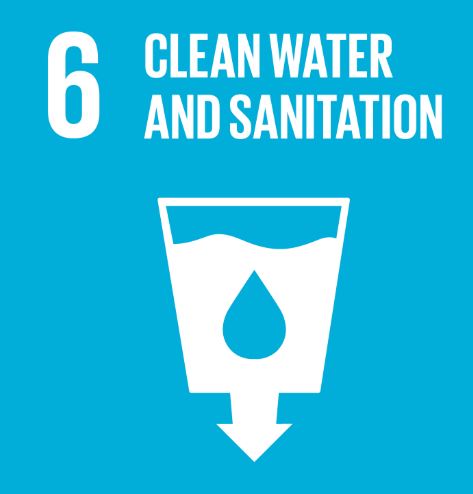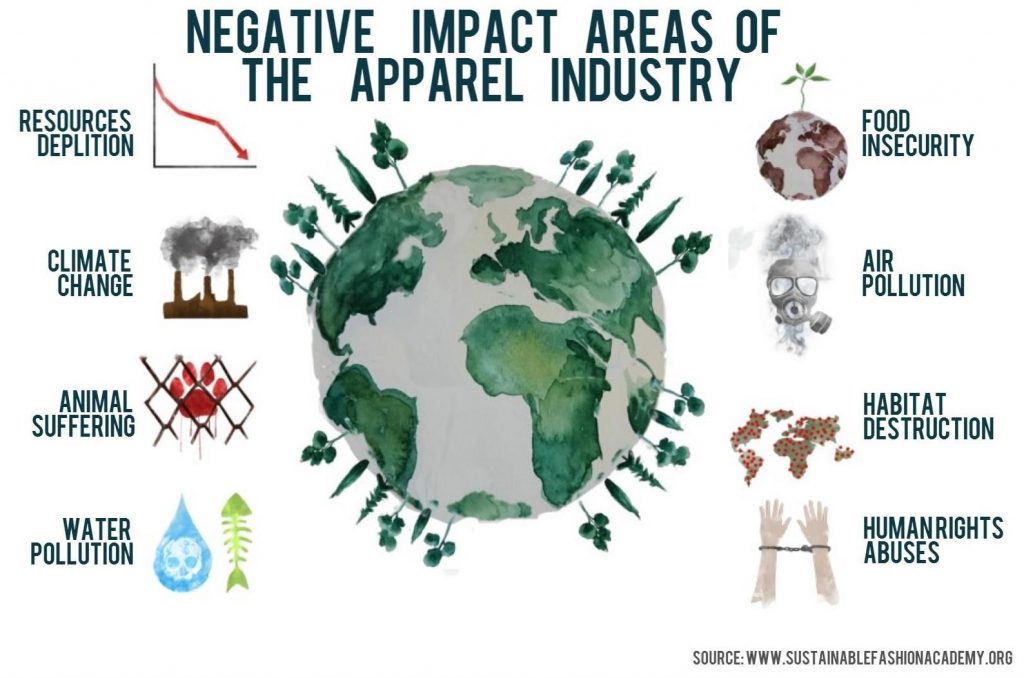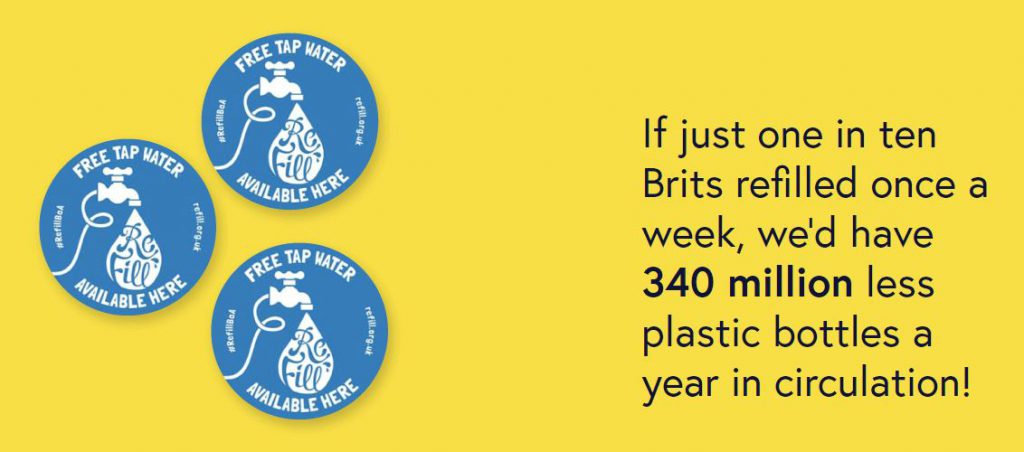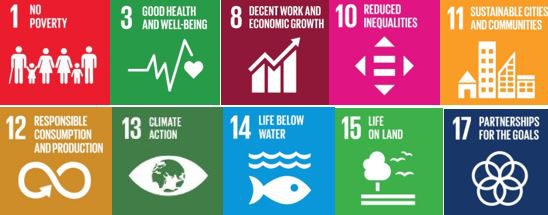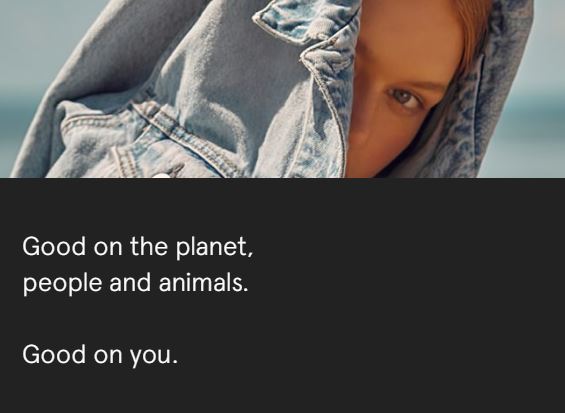We are excited to announce that our 2018-19 Environmental Sustainability Report is now available. It showcases the wide range of sustainability initiatives at King’s, and reports back on our sustainability commitments and targets. You can read the full report on the King’s website.
Category: Waste (Page 2 of 5)
This guest blog comes from Mathilde Funck Brentano and Irina Tabacaru who are the Director and Researcher at the King’s Think Tank Energy and Environment policy centre.
On Tuesday 11 February, the Energy and Environment Policy Centre hosted an exclusive panel event as part of King’s College London’s Sustainability Week. We welcomed Scott Ainslie (Former Green Party Member of the European Parliament), Adam Bartha (Director of EPICENTRE), and Professor Robert Lee (Director of the Centre for Legal Education and Research at the University of Birmingham) to discuss the future of environmental policies in the United Kingdom in the post-Brexit era. The three speakers answered multiple questions, notably on the strengths and weaknesses of the European Union’s environmental law, as well as more specific topics such as air pollution and energy policies. The speakers clearly expressed their perspectives and gave the audience a fascinating insight into the post-Brexit debate on environmental regulations.
The Energy & Environment policy centre began the event with an audience-directed poll, featuring the question: ‘Do you think the UK should move forward with stricter environmental regulation after Brexit?’. After some time to reflect, the majority responded in favour of stricter regulation.
Following the survey, the panel began by discussing whether the UK should uphold European environmental standards after Brexit. While the speakers displayed little confidence in the ability of the current UK government to expand environmental regulations, all three argued in favour of furthering the existing policies. Drawing from his experience as a specialist advisor in the drafting of environmental legislation in Northern Ireland and Wales, Professor Lee highlighted the importance of compromise in reaching higher-level objectives in environmental regulations. In order to enable effective policies to be successful, the accessibility of environmental regulations ought to be improved. The discussion also mentioned the importance of changes in consumption habits to match governmental policies. Mr. Bartha expressed optimism regarding the United Kingdom’s prospects after Brexit. As he noted, one of the European Union’s main weaknesses is its bureaucratic aspect, and the fact that European policies are not implemented by all member states evenly. For example, member states in Eastern Europe respond differently to environmental policies than those in Northern or Western Europe. The United Kingdom now has the possibility to expand sustainability-related regulations more freely across its territory, and avoid the European Union’s precautionary principles in the drafting of legislation, as well as the excessive allowances of the Emissions Trading System (ETS). Conversely, Mr Ainslie underlined the apparent lack of ambition demonstrated by the British government in regard to green policies, particularly when compared to European targets. The speakers also discussed the necessity of a kerosene tax, given the considerable amount of carbon dioxide emissions generated by air transport.

The discussion continued around the themes of Energy and Air Pollution. There was considerable disagreement between the speakers regarding the use and safety of shale gas as a potential alternative energy resource for the UK. The speakers’ views also diverged on the possibility of the UK reaching one hundred percent renewable energy use in the near future. Professor Lee also mentioned the importance of the UK finding its position concerning access to EU energy and, more importantly, pan-EU energy sources.
Our speakers expect that air quality standards will be upheld in the United Kingdom, despite its departure from the European Union. The British government has been tried several times by the European Court of Justice for failing to respect air quality standards. There is considerable public awareness on the topic, with approximately 28,000 to 36,000 pollution-related deaths in the UK every year. The necessity of tight cooperation between Westminster and local governmental bodies was put forth, as well as the urgent need for further enforcement.
Following the panelists’ discussion, the floor was opened to questions. The audience was extremely engaged in the discussion and interacted with the three panelists, raising a variety of issues, including the possibility of an EU-level meat tax. A captivating debate occurred regarding the theme of individual responsibility for climate change, as opposed to corporate and governmental responsibility. The high costs of sustainable and organic products, which represent a true burden for the average consumer, were extensively considered. The topic of waste management was also raised, following China’s decision to close its borders to foreign waste. Our panelists disagreed regarding the existence of the concept of ‘cyclical economy’, especially with reference to vehicles’ lithium ion batteries.
We would like to thank our three speakers for participating and sharing their thought-provoking insights with us. We would also like to thank the King’s Sustainability Team and KCLSU for their support in organizing our panel event. A big thank you also goes to our audience for being incredibly dynamic and engaged in the discussion. We look forward to welcoming you to King’s Think Tank events in the future!
This guest blog comes seventh in a series of blogs on the Sustainable Development Goals (SDGs) courtesy of Onna Malou van den Broek, second year doctorate student at King’s in the European & International Studies Department. Onna’s doctorate project titled: ‘The Political Payoff of Corporate Social Responsibility (CSR): CSR as a Determinant for Lobbying Success’, which looks at the relationship between corporate sustainability and lobbying, holding a special focus on the SDGs.
“We need to help these poor countries develop, to create industries that are able to compete globally, and better their lives” – as spoken by a British diplomat at a conference I recently attended. Without going into the problematic post-colonial mindset, it also raises a fundamental economic question (1). Underdeveloped countries need to develop. However, the so-called developed states are destroying our world. What will happen if all countries reach this level of industrialization?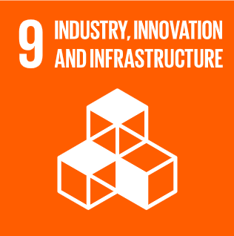
SDG 9: Innovation, industrialization and infrastructure
The starting point of this goal, just as we’ve discussed with goal 8, is that industries are the core drivers of the global development agenda (2). Reliable infrastructures and technological innovations are necessary to deliver the other goals, such as health care, sanitation and access to education. Some goals, for example, can be delivered through internet services. However, around 3.8 billion people, mainly from the least developed countries, still lack internet access. The growth of industries is closely tied to the global political economy. As a result of increased trade barriers and tariffs in 2018, global manufacturing and associated employment slowed down.
The Targets: Manufactory, mobility and research
This goal includes three broad issue areas which is reflected in the wide variety of indicators (3). Three indicators directly target the development of industries, aiming to stimulate inclusive industrialization; to provide access to financial credit for small and medium enterprises; and to make existing industries more sustainable in terms of clean and efficient resource-use. In addition, industry developments are heavily dependent upon innovation and, as such, the indicators aim to encourage industrial research and development through policies. Lastly, to include everyone in the process of industrialization, the indicators underline the importance of broad access to reliable infrastructure, such as all-season roads, energy-transmission or internet. Developed countries can support developing countries by providing access to novel information, finances and technology.
World’s system theory (Wallerstein)
 The central role of global political economy and trade has led to many critical scholars arguing the link between inequality and industrialization. One of the most influential is the world system theory, developed by the socialist Wallerstein in the late 20th century. This theory is influenced by the dependency theory and zooms in on the terms of trade (4). The main argument is that cheap labour and raw materials flow from low-income countries to high-income countries, who in turn, use these raw materials to manufacture goods which they sell for a much higher price back to low-income countries. This exploitative structure of trade and capitalism makes it difficult for low-income countries to escape.
The central role of global political economy and trade has led to many critical scholars arguing the link between inequality and industrialization. One of the most influential is the world system theory, developed by the socialist Wallerstein in the late 20th century. This theory is influenced by the dependency theory and zooms in on the terms of trade (4). The main argument is that cheap labour and raw materials flow from low-income countries to high-income countries, who in turn, use these raw materials to manufacture goods which they sell for a much higher price back to low-income countries. This exploitative structure of trade and capitalism makes it difficult for low-income countries to escape.
The Entrepreneurial State
Given that this is a government-led development Agenda, it is interesting that innovation is part of this goal. Some people have argued that innovation should be left to the dynamic entrepreneurs of the private sector instead of bureaucratic governments. In her book ‘the entrepreneurial state, Mariana Mazzucato refutes this argument and aims to debunk the public versus private sector myths. In her study, she finds that the private sector only finds the courage to invest after an entrepreneurial state has made the high-risk investments. For example, every technology that makes the iPhone so ‘smart’ was government funded. She criticises economic growth by showing a dysfunctional economic dynamic where the public sector socializes risks, while private sectors gets the rewards.
Resource-efficient infrastructures
Infrastructure developments, such as roads, buildings, energy and water infrastructure, are really resource intensive. They account for almost half of the global footprint. As such, resource efficiency of infrastructure can be a major driver of the transition to sustainable development. The UN Environment recently published a policy brief (6) in which they argue that our current project-by-project approach to infrastructure planning results in inefficient service delivery. System-level approaches, on the other hand, can increase the efficiency as they are better able to respond to user needs and capture positive industry spill-overs. This type of approach considers the economic, social and environmental impact of infrastructure systems, sectors, their location and relevant governance framework throughout the entire lifecycle, enabling industrial symbiosis and product circularity.
What can you do?
- Since this goal takes place on a systems-level, your first step is to inform yourself about issues such as global trade, international power imbalances and the grow-degrowth debate. There are plenty of resources. Books that I found useful are: ‘degrowth: a vocabulary for a new era’ and ‘a splendid exchange: how trade shaped the world’.
- Use your dissertation to contribute to knowledge around these topics. Talk to lectures about what research question might fit your specific programme and use your outcomes to start dialogues with different groups of people, such as policymakers, NGOs or firms.
- Due to the high level of abstractness, it is especially important to put pressure on your local, regional, national and international political representatives by tweeting, writing, voting, etc. to make sure they implement good policies.
References
(1) For a more elaborated discussion about economic growth, you can read the blog on SDG8 I wrote last month.
(2) Read more about why this goal matters: https://www.un.org/sustainabledevelopment/wp-content/uploads/2019/07/9.pdf
(3) Specific indicators, targets and progress can be found here: https://sustainabledevelopment.un.org/sdg9
(4) An easy and fun way of learning more about the system theory is through this video clip: https://www.youtube.com/watch?v=yRLd7xJNn14
(5) Buy the book at your local bookshop or watch the four things you need to know in 60 seconds: https://marianamazzucato.com/entrepreneurial-state/
(6) The UN policy brief can be found here: https://www.greengrowthknowledge.org/sites/default/files/downloads/resource/Policy%20Brief%20-%20Making%20Infrastructure%20Resource%20Efficient.pdf
This guest blog comes courtesy of Jo Hand, Co-founder of Giki Badges, mobile app which helps to inform and understand the impact of your UK supermarket products to guide a more sustainable lifestyle.
As the Christmas buying season gets into full swing, the plethora of choice in food, presents and holiday options can often feel a little overwhelming. But if you put a sustainability filter on your shopping trips, it can make for a happy green Christmas. Here are 8 ideas to get you started.
Avoid unsustainable palm oil
Palm Oil is used in mince pies, Christmas pudding, chocolates, gravy and lots more Christmas goodies. If it is not produced sustainably, it can cause deforestation in Indonesia and Malaysia, which is threatening species such as Orangutans, tigers and rhinos. But it’s possible to find sustainable or palm free options. Just check what you buy on The Giki app.
Try organic food
The great thing about Christmas is we cook so much from scratch, so have more choice over our ingredients. Although organic can be more expensive, a little planning to maximise leftovers can help reduce costs. Organic farming is significantly better for biodiversity, because no artificial chemicals are used and this means more insects and wildlife. It is also much better for soil health. You can get organic fruit, vegetables and meat in the supermarket, or via deliveries like Riverford and Abel and Cole.
Cut down on waste
This is great for the wallet and the environment. Food waste is responsible for up to 3% of our total environmental impact, or 16% of our food footprint[1]. So planning can help, and if you are still stuck with too many leftovers, put them on Olio. It’s a great way to make sure your food doesn’t go to waste, because plenty of other people might be keen to have it.
[1] Giki analysis based on an average UK diet with high levels of waste.
Streamline your food packaging
Wherever you can, buy food with better packaging, which you can recycle. You can check this on Giki, just scan and look for the green Better Packaging badge. No packaging is usually best, but often very hard to find. Recyclable packaging, as minimal as possible comes next. Both these options will help reduce waste to landfill.
Get arty with your wrapping paper
When it comes to wrapping paper, it can be a minefield. Much of it is nt recyclable, and we throw away over 100 million rolls every Christmas! So if you have an artistic streak, or kids who do, why not wrap in plain brown FSC paper (this hasn’t usually been bleached) and decorate it with your own picture. All the extras of ribbons and bows, tend to go straight to landfill and not buying them saves money!
Go for a family secret santa
Give the gift of experience
Instead of stuff, why not take someone out, or give your time or expertise. Offering your amazing babysitting skills to a sibling with young children, might be their favourite present yet! Or adopt them an animal from WWF or other charities.
Keep your feet on the ground
Flying significantly increases your carbon footprint. Flying economy class to Cape Town, or the Dominican Republic emits over 3 tonnes of CO2 – which is the same amount emitted by felling 4 acres of rainforest. A lower carbon option is to enjoy our UK Christmas traditions, or try the train to Europe.With over 2/3 of Brits now thinking about buying a present that has a positive social or environmental focus this year, 2019 is definitely a year of environmental awakening.
This guest blog comes courtesy of Ellie Blackmore, Marketing Coordinator for King’s Food.
Your morning coffee. You can’t function without it. Hitting a lecture without even a sip of caffeine? No thanks. But without a reusable cup, whether it’s a Keep Cup, a fancy bamboo tumbler you got for Christmas, or your dads old golfing flask, you’re contributing to the 2.5+ billion coffee cups that are thrown away every year, with less than 1% being recycled (Environmental Audit Committee, 2018).
This isn’t down to not trying – many people make the conscious effort to put the cardboard vessel that carried their morning latte in a recycling bin. The problem with this is that most disposable coffee cups have plastic in their inner lining, to make them both heat and leakproof, which stops them from being recycled and sends them straight to landfill.
Special recycling bins are few and far between, but King’s Food have installed them in all of their outlets. Simply pour any liquid into the centre of the bin, then pop your cup in the outer holes. Got a reusable cup? Even better, and no extra 20p cup levy charge* for you. Want a reusable cup? Pick one up at King’s Food cafes for £6.50.
King’s Food was recently awarded a 2-star Food Made Good Rating in recognition of commitments to sustainable catering – one of only seven British universities to have achieved this status. A 9% increase on last year’s score, highlighted successes include fair treatment of staff (e.g. all staff at King’s are paid London Living Wage), valuing natural resources (e.g. 100% electricity at King’s comes from renewable, wind energy) and celebrating local & seasonal products.
Local produce plays an important part of King’s Food, with elements of every day menus being sourced in London and the rest of the UK. Honey, from Bermondsey Street Bees, features in breakfast pots and the porridge bars at Chapters and Bytes Restaurant. Bread and pastries are supplied by Paul Rhodes, an award-winning bakery in Greenwich. King’s Food catered events offer attendees the chance to sip on cider made from London-pressed apples, by Hawkes Cidery in Bermondsey.
The positive impact of buying locally is indisputable: from the shorter distance the food travels, to the support it provides to local farms, communities and businesses. Not to mention the richer flavours and nutrients of the produce itself, all of which contribute to the delicious and sustainable food served at King’s Food venues.
One of many efforts to increase sustainability, Roots – King’s Food’s all-vegan café on the 8th floor of Bush House – opened in September 2018. Offering a selection of snacks, desserts, coffee and a different hot lunch every day, Roots is the first 100% plant-based university café in London. For the opening of Roots, the 2019 Green Gown Awards shortlisted King’s Food as a finalist in the Campus Health, Food and Drink category. The winner will be announced at the awards ceremony on November 26th.
Alongside Roots, King’s Food is committed to offering a vegetarian or vegan option every day at all of its outlets.
The Food Made Good rating offers advice on how King’s Food can make further improvements to become even more sustainable and to drive change in the sector.
King’s Food will focus on the following over the rest of the academic year:
- Continue with our focus on using local suppliers and explore using more produce from within 100 miles of London – which will likely increase the amount of produce which is organic.
- Keep investigating ways to reduce energy & water usage across all sites
- Look into our use of disposable packaging and how we can reduce it
- Develop a strategy or policy around healthy eating/menu planning
- Consider ways to further minimise food waste
*In February, King’s Food introduced a 20p cup levy to try and cut down the number of hot drinks sold in disposable cups across King’s campuses. Proceeds from the levy go into a Sustainability Projects Fund (SPF), the total of which is currently around £65,000. Applications for sustainability projects will open soon. KCLSU also committed their 20p disposable coffee cup levy to go into the SPF from August ’19.
This guest interview comes courtesy of Katherine Horsham, Operations Support Coordinator at the Entrepreneurship Institute at King’s. Katherine become a Sustainability Champion in November ’19 and joined King’s Sustainability and the Sustainable Living Communities on a trip to the Bywaters Materials Recovery Facility (MRF) in London.
- What is your name and what do you do at King’s?
I’m Katherine Horsham and I work in the Entrepreneurship Institute at King’s. Our mission is to support all students, staff and alumni to develop an entrepreneurial mindset to enhance their career and/or start a business. My role is focused on the Operations of the Entrepreneurship Institute.
- Why did you choose to become a Sustainability Champion?
I’ve been into all things the environment ever since I completed by Masters at King’s! I studied International Management and looking at the way economies worked prompted me to completely reconsider my lifestyle and career ambitions. Fast forward 10 years, and I’m now working at King’s. I manage our office space at the Entrepreneurship Institute, which means I have the opportunity to shape the way we do things to become more sustainable. And because we are a co-working space with 20 start-ups in it, there’s a lot of people-power, positivity and innovative thinking to make change happen!
- What does sustainability mean to you?
Sustainability is a way of living life that is conscious. It’s about committing to consider the impact of all our actions on the environment and changing our actions and systems as soon as we can. Ultimately it’s about respect for ourselves, each other and the other species that live on earth. Sustainability is inherently activist and collaborative and can’t be done from the side-lines. For me, thinking about sustainability is hugely liberating in our stressful modern world, and helps me to hone in on what I actually need to live a fulfilled life.
- Why did you attend this trip to a Materials Recovery Facility (MRF)?
Recycling and creating closed loop systems is essential to living sustainably. But I feel there’s so much unnecessary confusion around recycling due to the way it is managed by local authorities. Even in London, each borough has different rules around what can / cannot be recycled! I’ve also become more conscious about what happens to my recycling once it leaves the UK after several stories about it actually getting dumped in the sea, so getting behind the scenes is really important to me. Most household / workplace recycling is mixed into one bin, so I also wanted to understand how the MRF separated it all and how much of an issue contamination is. The trip was also a great chance to meet the King’s Sustainability team and other Sustainability Champions!
- What was something interesting that you learned?
It might sound stupid, but the thing that I found most interesting was how the got the recycling out of the bin bags! They put the full bags through a ‘bag shredder’ and then people tip the contents out onto large conveyer belts to sort. When I think of MRF facilities, I don’t imagine people involved at all thinking it is all powered by machines. I think these people do an amazing public service and thinking about them in the MRF makes me want to do everything I can to make sure what I put in my recycle bin is as it should be.
- What was the most surprising thing on the tour?
The sound of the MRF in action! It was strangely relaxing and there were so many different sounds coming together to make a piece of music I suggested they should record and sell! I’m sure it would wear off after a while though!
- Will this influence your behavior going forward? If so, how?
Visiting the MRF makes me want to see more of these places that do things to dispose / recycle our waste. I think it has also made me more interested in waste on a systematic level, and not just on what I do with my recycling. The visit highlighted the importance of the steps in the waste hierarchy before recycling – refuse, reduce and reuse – and how our aim really ought to be to reduce our need for recycling centres. There is a conflict of interest here because the businesses that recycle our waste need to make money and to do that they need a constant supply – if not a growing supply – of waste material.
- Given our monthly focus on SDG 12, why does reducing your consumption matter?
This goal matters as for me it is the essence of what sustainability is all about. If you’re not thinking about this, I don’t think you can say you are truly striving to be sustainable. Some people might say that consumption is okay as long as it can be recycled, but that is a false economy because of the energy (from people and machines) recycling requires to make, use and remake things
Each year, 8 million tonnes of plastic waste is added to our oceans – 250kg every second. To help solve this problem, King’s is committed to fighting single-use plastics.
King’s Sustainability Team and ResiLife’s Sustainable Living Communities will be teaming up with Bywaters on Friday 25 October to remove rubbish from the bankside of the River Thames. Link to register to the event, here.
By removing plastics (and other waste) from the Thames, our students and staff will play their part in preventing more waste from ending up in the ocean, and also help keep one of Britain’s most popular spaces sustainable for future visitors.
All of the waste we collect through the litter pick will then sorted for recycling at Bywaters’ state-of-the-art Materials Recovery Facility (MRF), with the resulting segregated waste being sent to specialist recycling plants across the UK.
Educating students on issues like this is important to King’s and it is the reason why, alongside providing the most sustainable waste management services possible, we’ve created a ResiLife initiative that focuses on a different Sustainable Development Goal every month.
This month (October 2019) is SDG6: Clean Water! We have been raising awareness of residents’ water use, thinking about how each of us can reduce the amount of single-use plastics that end up in our waterways, as well as giving away re-usable bottles, canvas bags, and other sustainable alternatives.
The aim of this initiative is to change perspectives – encouraging students to think about the importance of water in their lives and increase water-use efficiency, with the hope of protecting and restoring water-related ecosystems for present and future generations.
This week’s guest blog comes from Cristina Zheng Ji.
Every year, the Policy Institute encourages students and staff to pitch their policy ideas to a panel of experts. This year, the overall winner was second year Political Economy student Cristina, with her pitch to make the fashion industry more sustainable. We met up with Cristina to talk about what inspired her to take part, why sustainability in fashion is important, and how consumers can influence industry.
What inspired you to take part in Policy Idol?
Cristina: One of my lecturers suggested it as a great opportunity, so I decided to look at it. I had two ideas for a pitch, but narrowed it down to this one.
What is the Environmental Cost Labelling System?
C: It’s a labelling system to raise awareness of the environmental impact of clothing production. This would involve using the traffic lights system: red for the highest environmental cost through to green for the lowest and apply it to four categories of impact – water use, energy use, scope to recycle, and whether it is biodegradable.
What inspired you to do a pitch on sustainable fashion? Did you come across sustainability in your degree?
C: I was inspired by a YouTube video I saw on how there is an increased accumulation of plastic fibres in the environment. Synthetic materials like polyester, nylon and acrylic break up in a washing machine cycle and get into water streams. The numbers were astonishing: a washing load can realise up to 700 000 fibres in a single wash. This made me think about how people can reduce or change their consumption of polluting clothing – for example to pieces that don’t release plastic fibres. After looking deeper into the issue, I also found out that disposable fashion caused other severe environmental damages, too. Sadly, information about the impact of clothes on nature is not easily available, so I thought it would be useful to do something to aid consumers when they go shopping. I narrowed the environmental factors down to four categories, which can be changed after feedback from experts. I was also inspired by the traffic lights system in the food industry which colour coded food to provide nutritional information at a glance.
Sustainability is a general interest of mine, but not a formal part of my degree. Sometimes people around you also have a good influence – at home my parent’s generation wasn’t as aware of recycling, but coming to university my friends are very aware. And climate change is a huge issue with a wide range of threats, so it’s good to focus on sustainability. My other idea was also on climate change.
Why is fashion so important?
C: Many people are not aware of how polluting the industry is – it is the second biggest polluter in the world after the oil industry and bigger than shipping and aviation industries combined. We know that cars, shipping and flying have a big impact on greenhouse gas emissions, but we don’t know about clothing. With the fast fashion model of ‘Take, Make, Dispose’ – where we buy clothes, wear them two or three times, and then throw them away –, people buy and dispose a lot of clothes. In Britain, more than 300 000 tonnes of clothes end up in landfill every year. And people will still buy fast fashion as it’s a habit and generally affordable to most, but I believe that once people are aware of it, they might change their behaviour.
I think it is important to give consumers the choice. The idea for the pitch came from the idea of ‘nudging’. Some people see nudging to be paternalistic; however, it preserves people’s freedom to choose according to their own preferences. With the Environmental Cost Labelling System, options of good/neutral/bad are given, so if people want to make the ‘bad’ environmental choice they can do this, but one day they might choose the ‘good’ option instead. For those who have not thought the green issues much yet, the labelling could nudge them towards the better option. And for those who already choose a ‘green’ lifestyle, a lack of relevant information in the fashion industry makes this difficult. Ethical and sustainable fashion is often expensive. If we target the high street with this labelling system, we can bring sustainability to consumers without them having to research brands they don’t know, or spend more money.
Do you think this will lead companies to change their practices?
C: I think it will do. A change in the consumer purchasing behaviour can lead to a change in the manufacturer’s behaviour as they see an increase in demand in sustainable clothes and a decrease in unsustainable ones. Companies also have something to gain from this. If consumers switch to more sustainable brands, it will reward brands working on sustainability.
And companies know that sustainability is important, and that they can’t go on like this. For example, Levi Strauss & Co. make denim from cotton, but know that an uncontrolled and irresponsible resource use of this is wasteful and unsustainable. They are now working towards a circular economy where they encourage the consumer to take their old clothes and shoes back to the stores to be recycled.
What would the system look like, how would it work?
C: The four categories are a starting point – these could be changed after expert reviews. The information would be on clothing tags. Most clothes have a price tag, and also an additional one with information on the brand, or for example one I saw only says ‘We are denim’ 10 times. To replace this, I have designed a tag that has the Environmental Cost Labelling System with the traffic lights on it. In the food industry, the traffic lights labelling is not mandatory, so different brands may set their own standards. If this were to be made mandatory for clothing, and there was a universal agreement of standards for each colour, this could be powerful. There are already websites and non-profits out there that collate information on sustainability of clothing – we could work with them.
Just having a label to simply say ‘sustainable’ isn’t enough. There are so many aspects related to sustainability, and the Environmental Cost Labelling System would allow consumers to consider which aspects are the most important to them when they go shopping – e.g. energy use, water etc. The traffic light system also tells us about intensity, and not just pass/fail – it gives more power to the consumer.
After winning the overall prize at this year’s Policy Idol, Cristina is now looking at working with the Policy Institute to take her idea further. We hope that in the future, we might see this labeling system on the clothes we buy!
Eco-Friendly Search Engines
Ecosia
Ecosia is a certified B Corp and was founded in 2009. It’s mission is to cultivate a greener world and has the goal to plant one billion new trees by the year 2020.
Ecosia does this by donating at least 80% of its advertising income to tree planting programs in Burkina Faso, Madagascar, and Peru. It currently has 7 million active users and has planted over 52, 000, 000 trees so far.
Using the app (or desktop search engine) is an easy way to make a difference.
(Ecosia also doesn’t sell your data to advertisers nor have third party trackers, unlike other some of the larger search engines…)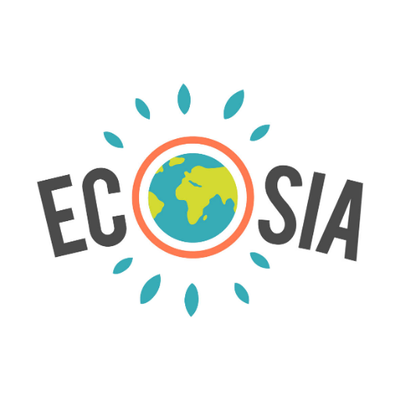
Tackling Food Waste
10 million tonnes of food is chucked away in UK every year. That’s equivalent to wasting £17 billion or £700, on average per household.
Olio
Olio is part of the ‘food sharing revolution’. This app connects people who have food to give away. There are 907,000 people have joined the Olio platform, and so far, has saved 1,218,03 portions of food!
To advertise food: download the app, snap a picture, give the item a short description & when and where the item is available for pick-up.
Too good to go
This app allows food outlets (Restaurants, Cafés, Bakeries etc.) to advertise any food they have left over at the end of the day– to be sold in Too Good To Go’s ‘magic bags’ for heavily discounted prices.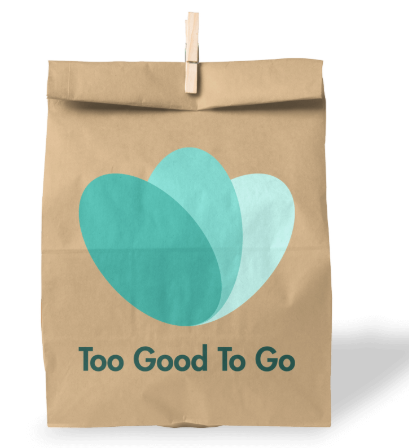
So far, Too Good To Go has partnered with 1,488 stores (such as Yo! Sushi and Paul) across the UK, saving 479, 094 meals from the bin (equivalent to saving approx. 958,188 Kg of CO2). To learn more about Too Good To Go, watch their video here.
Plastic Reduction
Refill
A million plastic bottles are bought around the world every minute.
The Refill app locates sources of free drinking water wherever you are. In London there are over 900 refill stations. Around King’s, there are over 42 refill points around Strand, 38 near Waterloo, 17 around Guys , 10 by St Thomas’ & 4 close to Denmark Hill.
Using Refill helps to reduce use of disposable plastic water bottles (nearly half of the bottles in the UK are not recycled, with more than 15 million littered) and save carbon emissions connected to the disposable plastic production. Refill also receives 13p for every refill logged on the app, which goes towards planet protecting campaigns.
(The King’s App can also help you locate re-fill station inside of each King’s campus).
Keep your refillable bottle with you and you’ll never go thirsty again!
Sustainable Fashion
Good On You
Good On You gives you ethical ratings to over 1,000 high street fashion brands. These ratings encompass not just environmental sustainability (e.g. assessing the company’s energy and water intensity, chemical use and disposal), but social sustainability; analysing factors such as child and forced labour, worker safety, freedom of association and payment of the living wage. Good On You also builds the rating around if any animals are used (reduced scores linked to the use of angora, down feather, shearling, karakul and exotic animal skin/hair, wool and leather).
Users can feedback and make requests of the brands.
Read more on how Good On You and how they rate here.
This week’s guest blog comes courtesy of Jane Picciano, who is a Sustainability Champion working in the Library Services Team at King’s.
King’s Food waste goes to Anaerobic Digestion (AD), which helps to meet the following Sustainable Development Goals:

This is the story of what happens to all food waste from King’s!

I got a chance to join the King’s Sustainability team on a visit to an Anaerobic Digestion plant (Agrivert) in Virginia Water which was coordinated with Simply Waste, the food waste collection company for King’s. The tour was led by Charlie who has worked in the recycling industry for over 15 years, starting in local recycling then moving into food specific recycling.
This plant is where all King’s food waste goes to be ‘digested’ then reused as fuel in a methane gas form to power their machines, with any extra sold back to the grid to power 4400 local homes, and as compost to local farmers.
Big trucks drive up to the entrance, as they arrive they punch in a designated code which identifies which company they come from. A scale under the driveway weighs the vehicle and then the vehicle is given the green light to go into the recycling bunker. Once inside, the food waste load is dumped into a deep concrete ‘mouth’ where the process of decomposition begins.
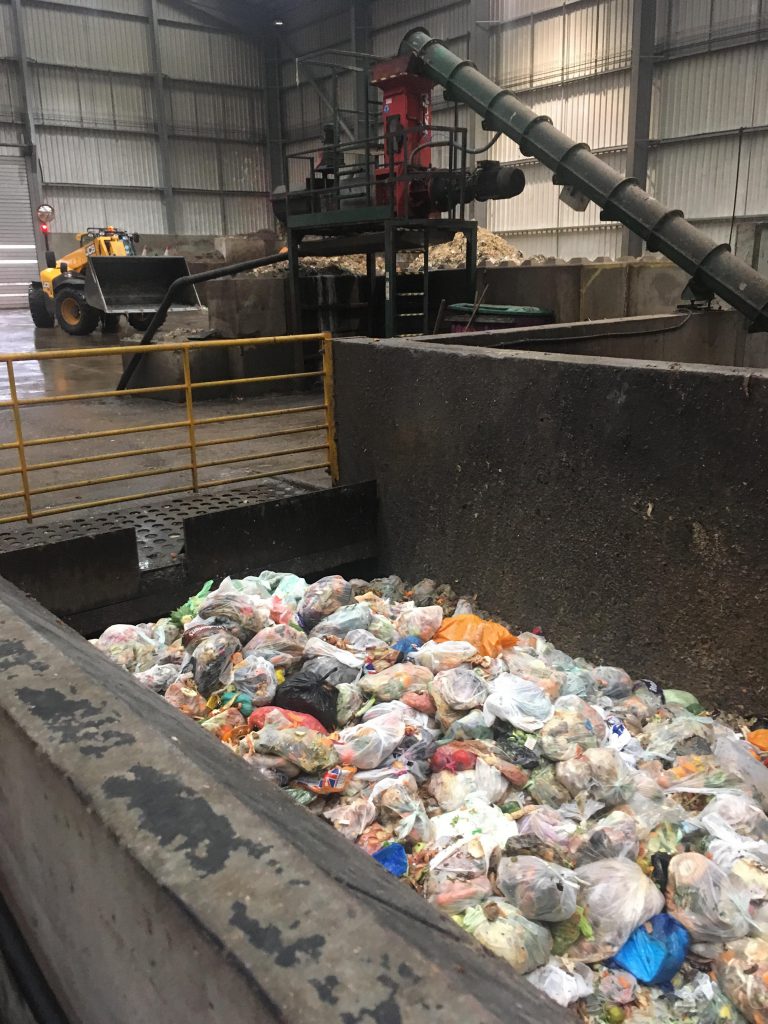
Once the food waste is dumped into this concrete stomach, the waste is mixed with water to make it easier for any plastic contamination to be sieved out. This is where the plastic contaminated waste comes out and next to it a photo of said waste. The plastic waste is sent to an Energy from Waste Plant.
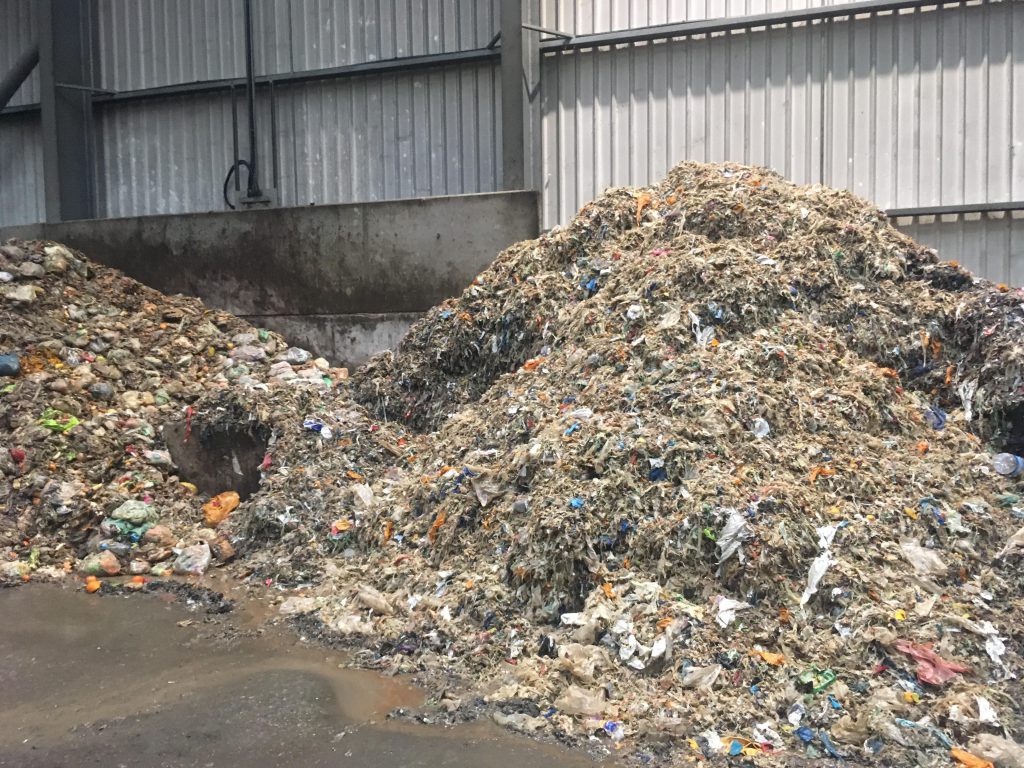
We were told that most food waste recycling companies prefer food to be in plastic bags rather than biodegradable bags as they are very hard to separate from the food. Biodegradable bags stretch and don’t break as easy which makes them dangerous to the machinery that chops everything up finely for digestion. In addition, they contain more water than plastic, so cannot be burned effectively to get energy from waste. If you look closely at the picture of plastic waste, you can see how big the waste is and how easy it is to sift it out.
Once that is all done, the food waste sludge goes through one more pipe and any tiny bits of plastic and grit not caught by the grinder is siphoned out. After this, the waste is ready to go and gets fed into one of the holding tanks (or ‘Stomachs’ of the plant).
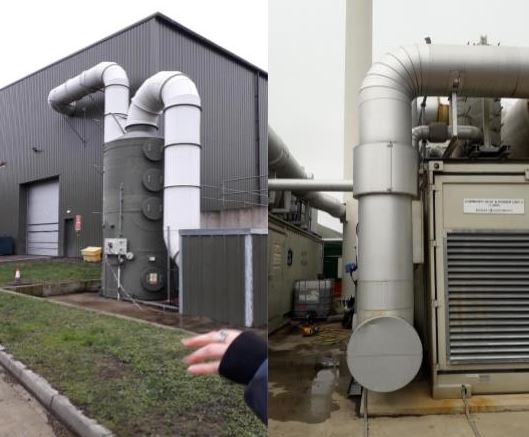
The food waste is now ready for a long ferment (75 days in fact) in one of the five tanks they have. Having the luxury of five tanks gives Agrivert the choice to choose which one to use first and helps them if for some reason there is any kind of mechanical issue or if one of the tanks becomes ‘sick’.
Anything can make a tank sick – we were told to think of it like our own digestive system, in that when you have something that doesn’t agree with you, you might need to a bland diet of something like chicken and rice for a few days to get your stomach back to normal. If one of their batches does gets sick, Agrivert has a ‘chicken and rice’ equivalent that they feed the tank and they soon feel better and are healthy again and they can get back to work! Making sure that the food waste is of a wide variety is important, if the tanks just receive one type of food – such load of bread or curry, the chance of getting sick increases (just like if a human only at one type of food for a long time). Therefore, Agrivert makes sure to balance what the tank receives to reduce the change of it getting sick before the ‘chicken & rice’ is necessary.
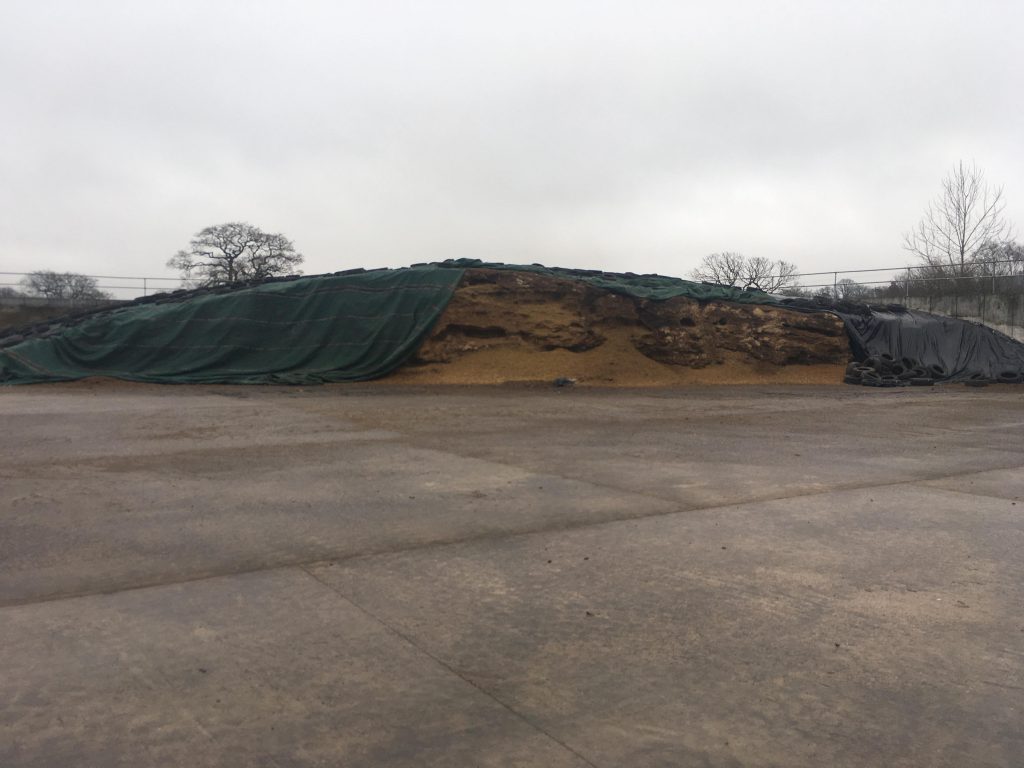
You will notice that all the tanks have soft domes on them, this is where the gas created by the process collects and is then used to power the Agrivert machinery with any extra sold back to the grid. The power generated from their left-over gasses power up to 4500 local homes per year. The soft domes help identify when there is a problem with the tank, as it will appear sunken and not fully inflated as seen in the images below.
You can see the large motors on the outside of the tanks. These are blades that move the food sludge and make sure it is turning continually and kept warm throughout the whole process (at body temperature – around 37 degrees). The blades are different sizes and heights so that everything moves around and utilizes the whole tank.
The two long implements you can see above are examples of what the blades that churn the food waste around the tank look like.
It was interesting to see the re-purposing of shipping containers; these are being used as heat diffusion containers and the had several more as office and staff room space. The entrance has room for a couple of small offices, a large meeting room and presentation space as well as a kitchen and toilet facilities for the staff and guests.

The last bit of the tour took us past the huge pipe that you see below; we were told that if this pipe ever stops working it would lead to a very loud and dangerous explosion – it means that the methane expelled from the tanks is not moving freely around and has stopped, building up pressure and finally, exploding. Thankfully that’s has never happened at this Agrivert plant but has happened at others.

And this is the story of what happens to the food waste collected at King’s College London!
If you get the chance, I would recommend you go and see how one of these plants operates (The Sustainability Team put on one or two trips to King’s waste facilities a year, follow Sustainability Team social media and newsletter to keep up to date on the next). If anything, visiting one of these plants will give you hope for the future of recycling and show you that it is possible to turn waste; food or otherwise into reusable energy that can power homes and fertilize crops.
The only thing I would strongly suggest is: bring something to cover your nose & mouth, as the smell is overpowering and it lingers on clothes.
I can’t even describe it. 🤢
Jane Picciano, Sustainability Champion Gold, Maughan Library














